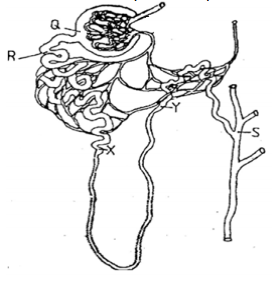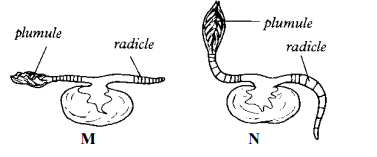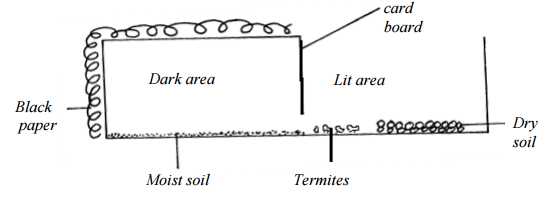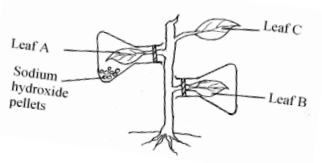- Name the tissues whose cells are thickened with:
- Cellulose and pectin. (1mk)
Collenchyma
- Lignin. (1mk)
Sclerenchyma
- Cellulose and pectin. (1mk)
- The diagram below represents a fern.
- Name Parts labeled A and B. (2mk)
A. Sori
B. Rhizome
- To which division does the plant belong? (1mk)
Pteridophyta
- Name Parts labeled A and B. (2mk)
- State three measures that can be taken to control infection of man by protozoan parasites (3mk)
-Improving sanitation/hygiene;
-using insecticides to kill vectors;
-avoiding indiscriminate sexual intercourse;
-clearing bushes/tall grass around the house;
-draining stagnant water;
-proper disposal of household refuse; - Explain how the following factors hinder self pollination in plants:
- Protogyny(1mk)
Stigma matures earlier and is ready to receive pollen grains before the anthers are ready;
- Dioecism(1mk)
Male and female gametes occur in separate plants;
- Protogyny(1mk)
- Explain the likely effect on humans and other organisms of untreated sewage discharged into water body that supplies water for domestic use. (3mk)
-Contains disease – causing micro-organisms which may cause outbreak of water borne diseases;
-faecal material is broken down by saprophytes leading to depletion of dissolved oxygen thus suffocation of aquatic organisms;
-breakdown of matter releases nutrients which enrich the water resulting in eutrophication; - Name two structures in herbaceous stems that enhance their support. (2mk)
-Possession of hooked spines;
-tendrils;
-twining stems;
-adventitious roots; - Define the term immunity. (1mk)
Ability of the body to identify/ recognize foreign antigens and develop mechanisms of destroying them / ability to resist infection;
- Distinguish between natural immunity and acquired immunity. (1mk)
Natural immunity is inborn /inherited /passed from parents to offspring while acquired immunity is obtained in life;
- Identify one immunizable disease in Kenya. (1mk)
-Tuberculosis
-poliomyelitis
-diphtheria
-whooping cough
-measles
- Define the term immunity. (1mk)
- State three differences between osmosis and active transport. (3mk)
-Osmosis involves movement of water /solvent molecules, active transport involves movement of solute molecules;
-osmosis does not require energy, active transport requires energy
-in osmosis molecules move along a concentration gradient, in active transport molecules move against a concentration gradient; - The diagram below illustrates part of a nephron from a mammalian kidney.
- Name the fluid found in the part labeled Q. (1mk)
Glomerular filtrate
- Identify the process responsible for the formation of the fluid named in (a) above. (1mk)
Ultra-filtration / pressure filtration;
- Which two hormones exert their effect in the nephron? (2mk)
-Antidiuretic hormone / vasopressin;
-Aldosterone;
- Name the fluid found in the part labeled Q. (1mk)
- State three characteristics of members of kingdom Monera that are not found in other kingdoms. (3mk)
Nucleus lack nuclear membrane / organelles not membrane bound; nucleus not organized; mitochondria absent / most organelles absent; cell wall made of mucoprotein;
- What is meant by the following biological terms?
- Crenation (1mk)
Shrinking of red blood cells/ animal cells as a result of water loss by osmosis (when placed in hypertonic solution);
- Haemolysis (1mk)
Bursting of red blood cells as a result of uptake of water by osmosis (when placed in hypotonic solution);
- Plasmolysis (1mk)
Shrinking and pulling away of the cell membrane from the cell wall of plant as a result of water loss by osmosis;
- Crenation (1mk)
- The diagram below shows a stage during fertilization in flowering plant.
- Name the parts labeled Q, R, and S. (3 mk)
Q – Antipodal cell(s);
R – Polar nucleus / body;
S – Functional egg cell;
- State the function of the pollen tube. (1 mk)
-pathway through which male nuclei reach the embryo sac / improves efficiency of fertilization;
-its tip produce lytic enzyme which dissolves the embyo sac wall to allow entry of male nuclei;
- Name the parts labeled Q, R, and S. (3 mk)
- State the major factor in the ‘Global warming’ experienced in the world today. (1mk)
Carbon (IV) Oxide
- Suggest two ways of reducing the Global warming. (2mk)
-Reducing use wood / fossil fuels;
-planting more trees / afforestation or re-afforestation;
- State the major factor in the ‘Global warming’ experienced in the world today. (1mk)
- An experiment was set to investigate a certain aspect of response. A seedling was put on a horizontal position as shown in figure M below. After 24 hours, the set up was as shown in figure N.
- Name the response exhibited. (1mk)
Geotropism
- Explain the curvature of the shoot upwards. (3mk)
Gravity causes high concentration of auxins on the lower part of the shoot; this causes faster elongation of cells on the lower part compared to the upper part; making the shoot to curve upwards
- Name the response exhibited. (1mk)
- The paddles of whales and the fins of fish adapt these organisms to aquatic habitats.
- Name the evolutionary process that may have given rise to these structures. (1mk)
Convergent evolution
- What is the name given to such structures? (1mk)
Analogous structures
- Give two examples of vestigial organs in man. (2mk)
-Coccyx;
-appendix;
- Name the evolutionary process that may have given rise to these structures. (1mk)
- Name a protein and vitamin involved in blood clotting.
- Protein.(1mk)
Fibrinogen
- Vitamin(1mk)
(Vitamin) K;
- Protein.(1mk)
- Explain why blood is not normally used for transfusion after one month. (1mk)
Most of the red blood cells will have died
- Name a protein and vitamin involved in blood clotting.
- A group of Form four students set up an experiment to investigate a biological process using termites. They used a small box in which a portion was covered with black paper and had moist soil. The open part had dry soil. Termites were placed inside in open area of the box.
- Predict what happened to the termites after 30 minutes. (1mk)
Moved to the dark area
- What form of response is exhibited by termites? (1mk)
Negative phototaxis / positive hydrotaxis
- State one biological significance of the above response to termites.(1mk)
-To escape predation;
-to reduce dessication;
- Predict what happened to the termites after 30 minutes. (1mk)
- Name two fins in a bony fish which perform the following functions:-
- Changing direction. (1mk)
Pectoral fins
- Control pitching. (1mk)
Pectoral and pelvic fins
- Changing direction. (1mk)
- State the role of myotomes in fish. (1mk)
Contract and relax alternately to bring about undulating movement
- Name two fins in a bony fish which perform the following functions:-
- The diagram below represents an experimental set up to investigate a certain scientific concept. The potted plant was first destarched by keeping it in dark for four days.
The set up was then placed in sunlight for five hours and leaves were tested for starch.- What scientific concept was being investigated? (1mk)
Photosynthesis
- Give the results likely to be obtained after starch test for A and B.
Negative test / starch absent
Positive test / starch present
- Account for the results in leaf A in b (i) above. (1mk)
Sodium hydroxide absorbed all the Carbon (IV) Oxide hence no photosynthesis
- Give the results likely to be obtained after starch test for A and B.
- Why was leaf C included in the set-up? (1mk)
Control experiment
- What scientific concept was being investigated? (1mk)
- Explain the importance of transport in plants. (2mk)
-Supplies water and mineral ions to the (photosynthetic) cells;
-conduct products of photosynthesis / nutrients to all parts of the plant / translocation; - What is the role of root hairs in plants? (1mk)
Absorption of water and mineral ions from the soil
- Explain the importance of transport in plants. (2mk)
- Identify the source of urea that is removed via the kidneys in a healthy human being. (1mk)
Deamination of excess proteins / amino acids in the liver
- Explain why a pregnant woman excretes less urea compared to a woman who is non-pregnant. (2mk)
Amino acids are used in the formation of foetal tissues; thus has less excess to be eliminated
- Identify the source of urea that is removed via the kidneys in a healthy human being. (1mk)
- Study the reaction below and answer the questions that follow.
- What biological processes are represented by A and B? (2mk)
A – Condensation
B – Hydrolysis
- Identify the product Y. (1mk)
Sucrose
- State the bond represented by X. (1mk)
Glycosidic
- What biological processes are represented by A and B? (2mk)
- Explain the events of the light stage of photosynthesis. (3mk)
-Light energy is s absorbed by chlorophyll molecules;
-used to split water molecule into oxygen and hydrogen atoms/ ions;
-light energy is converted into chemical energy (ATP) and stored - Explain what happens in humans when the concentration of glucose in the blood rises above the normal level. (3mk)
-Insulin is produced which increases oxidation of glucose;
-facilitate conversion of glucose into glycogen / fats for storage;
-inhibits conversion of glycogen into glucose; - Outline the main features of Lamarckian theory of evolution. (2mk)
Use and disuse of structures / when structures are not used for a long time they shrink and when used they develop properly; transmission of physically acquired characteristics / physically acquired characteristics are passed on to the offspring;
- In view of modern genetics, explain why Lamarck’s theory is unacceptable. (1mk)
phynotypically / physically acquired characteristics which do not affect the genes cannot be inherited;
- Name one factor in nature that increases the process of evolution. (1mk)
-Natural selection;
-cross- breeding;
-mutation;
- Outline the main features of Lamarckian theory of evolution. (2mk)
Download MOKASA Joint Evaluation Examination Biology Paper 1 2016- Pre MOCK With answers.
Tap Here to Download for 50/-
Get on WhatsApp for 50/-
Why download?
- ✔ To read offline at any time.
- ✔ To Print at your convenience
- ✔ Share Easily with Friends / Students








